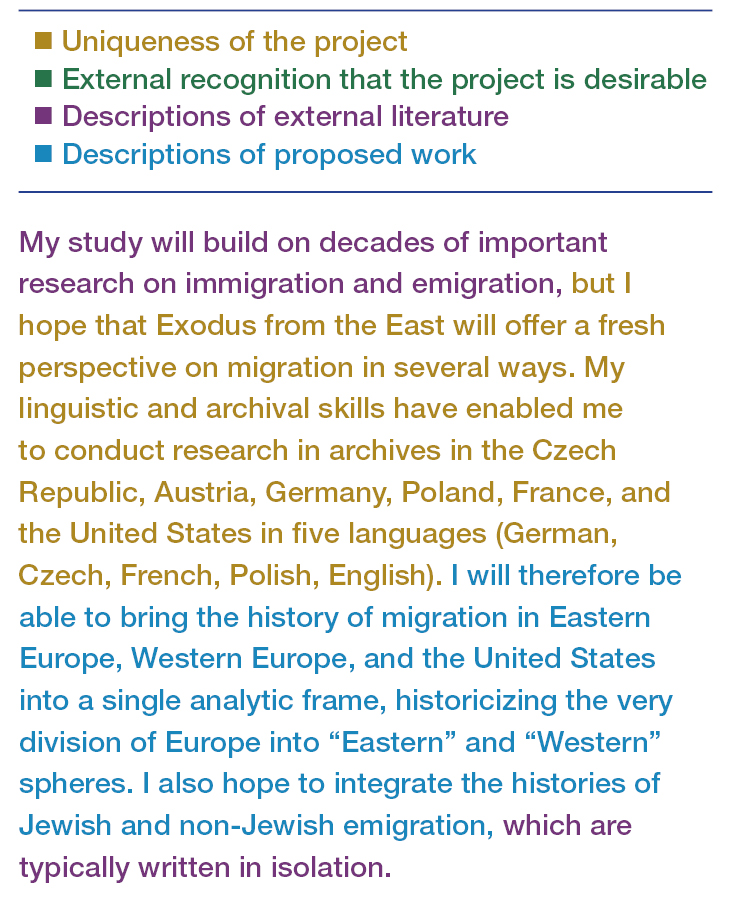First and Never
Case Study 3: Divided Literature (A)
Literature on immigration and emigration is too copious to get away with a claim that there will not be significant overlap of raw subject matter. This elevates the importance of perspective and, in this case, a fresh analytic frame. However interesting the project, it is made more interesting by presenting the literature as fractious and divided. In the following excerpt, we will see the author lament
1. “the very division of Europe into ‘Eastern' and ‘Western' spheres,”
2. “the histories of Jewish and non-Jewish emigration, which are typically written in isolation,”
3. “many bi-polar histories of migration: Poles in Chicago, Italians in New York, Algerians in France, Turks in Germany, etc.”,
4. Divisions between “histories of ‘voluntary' labor migration in the nineteenth century and ‘forced' refugee movements in the twentieth…the distinction between ‘economic' and ‘political' migrants.”
And we will likewise read that all of these trends can be solved by the application of the particular unifying analytic frame hit on by the author—owing not just to their ingenuity in formulating the project, but also their unique skillset enabling it.
![]()

The person who will be doing the project is treated as inseparable from the project. The author's multilingualism and archival skills are explicitly referenced. All of these things are understood to be related. It must be a remarkably small crowd with the linguistic and archival skills to do what the author has already done, let alone present the right motivation. No one else will do a project like this, the paragraphs imply, because only I could have done this. This is an appropriate moment to point out the basic fact that fellowships support individuals. Particularly with NEH, the project is expected to be in a relatively advanced state—note that research has already been conducted in six countries in five language. The desired funds are about giving them breathing room to complete an exciting project. In this context, the inseparability of the project from the person can only help to convince reviewers that something unique will be carved out of the scholarly landscape. It also forestalls questions such as: if your project is so great, why hasn't someone done it already? The answer, here, is: no one else could!
Again, the project is uniquely meritorious. Its very scope is a panacea for a torn, "bipolar" literature. The proposal will treat emigration "from a larger region (roughly, the former lands of the Hapsburg Empire) to multiple destination." Of course, simply writing about emigration from the former lands of the Hapsburg Empire does not automatically unify all these histories. This is implicitly conceded: "I also hope to integrate [them]," the author writes about the "histories of Jewish and non-Jewish emigration." What the author has achieved in this section is not proof that they will achieve these goals. Rather, by presenting them as goals in the first place, the reader is assured that this is not just a question of salesmanship; this unifying effort is baked into the project design.
Also, the aforementioned point about level of preparation helps here. If the author proposes to "historicize the very division of Europe into "Eastern" and "Western" spheres, it helps to have already pored over documents in five languages at archives in six countries. Generally speaking, the greater your level of preparation, the more credible your claims will be perceived to be.
Contact:
Nural Akchurin, Associate Dean for Research
College of Arts & Sciences
806.834.8838
nural.akchurin@ttu.edu
![]()
College of Arts & Sciences
-
Address
Texas Tech University, Box 41034, Lubbock, TX 79409-1034 -
Phone
806.742.3831 -
Email
arts-and-sciences@ttu.edu
